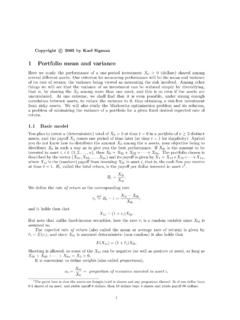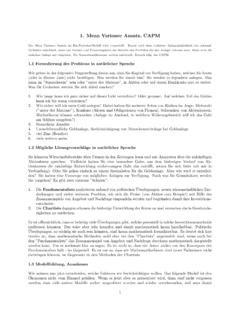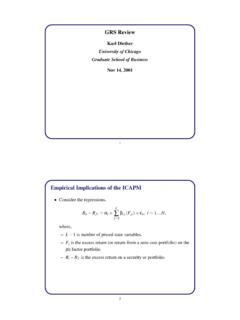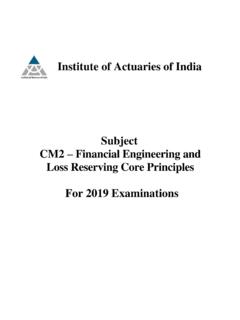Transcription of 1 Fund theorems - Columbia University
1 Copyrightc 2005 by Karl Sigman1 fund theoremsIn the Markowitz problem, we assumed that allnassets are risky; 2i>0, i {1,2, .. , n}.This lead to the efficient frontier as a curve starting from the minimum variance learned that in this case, this entire curve can be generated from just two distinctportfolios (funds) each with points on the curve. This is known as thetwo- fund theoremand will be reviewed again in the next section. Then, we will explore what happenswhen we allow one of the assets to be risk-free, and show that then the efficient frontieris simply a line connecting the risk-free asset to a particular fund of the risky assets. Thisis called theone- fund theorem , and it will be presented Two- fund theoremIn Lecture Notes 3, Section we learned that the entire efficient frontier can be gen-erated from only two portfolios (funds). In other words if we letw1= ( 11, 12, .. , 1n)be a solution to the Markowitz problem for a given expected rate of returnr1, andw2= ( 21, 22.)
2 , 2n) be a solution to the Markowitz problem for a different given ex-pected rate of returnr2, then for any number , the new portfolio w1+ (1 )w2isitself a solution to the Markowitz problem for expected rate of return r1+ (1 ) varies,r= r1+ (1 )r2takes on all feasible values for expected rate of return;thus all solutions to the Markowitz problem can be constructed. This is known asthetwo- fund each of the two fixed distinct solutions as portfolios and hence as assets intheir own right, we conclude that we all can obtain any desired investment performanceby investing in these two assets only. The idea is to think of each of these two assetsas mutual funds, and create your investment by investing in these two funds only. Inpractice, one might first solve for the minimum variance portfolio as one such solution tobe used as one of the two Allowing for a risk-free assetIn the previous analysis, we assumed all assets were risky. In reality there is always theopportunity to borrow/lend money at some fixed interest rater.
3 Lending refers to (say)the buying of bond or placing cash in a savings account, whereas borrowing refers totaking out a loan. For simplicity of analysis, we will imagine some fixed such raterfforboth borrowing and lending. This type of risk-free investment can simply be treated asyet another kind of asset to be used in a portfolio. A positive weight refers to lending anda negative weight to borrowing: If you borrowx0at timet= 0, then you must returnx1=x0(1+rf) at timet= 1 (orx0erfif compounding continuously). This risk-free assethas 2= 0 andr=rf. Since 2= 0, our previous analysis for finding the minimumvariance portfolio makes no sense: The minimum variance is zero and can be obtainedby investing all of your resources in the risk-free asset. But the risk-free asset has a lowerrate of return than the risky assets which is why one would choose a portfolio combiningboth types of assets: the risk-free asset helps keep the risk down, whereas the risky assetshelp drive the expected rate of return up.
4 Mixing the two still yields an efficient frontierin which a desired expected rate of return can be obtained with minimum variance, but,1as we shall see, this new effficient frontier turns out to be a line; its analysis is thus quiteeasy, we discuss all this New efficient frontier is a lineConsidernassets denoted byA1, .. , Anwith rates of returnrihaving meanriandvariance 2i. Now suppose the risk-free asset with (deterministic) raterf, is joined denote this asset does this added risk-free asset effect the feasible region and efficient frontier? Wewill refer to the feasible region and efficient frontier of only thenrisky assets as theoldfeasible region and theoldefficient frontier, and the feasible region and frontier includingA0as thenew. Recall that the feasible region is by definition all achievable points ( ,r)in the two-dimensional rplane. By achievable we mean obtained by some will use ( 1, .. , n) to denote a portfolio of thenrisky assets; 1+ + n= 1,and we will refer to any such portfolio as afund.
5 We will use ( 0, 1, .. , n) to denotea portfolio of alln+ 1 assets; 0+ 1+ + n= the new feasible region contains the old since by choosing 0= 0 we obtainall points in the 0+ 1+..+ n= 1, we can, noting that 1 0= 1+..+ n, re-write theportfolio as( 0,(1 0)( 1, .. , n)),where i= i1 1+ + n= 1 we conclude that the portfolio has been re-written as a portfolioof only two assets :A0and the given fund ( 1, .. , n). The weights are 0and 1 the other hand, every fund ( 1, .. , n) can be viewed as an asset and then used toconstruct a portfolio of itself withA0. We conclude that the collection of all two-asset portfolios made up ofA0and a fund is the same as all portfolios ofA0, .. , An. So wecan determine the new feasible set and efficient frontier by looking at the ( ,r) points ofall the two-asset (A0, fund ) fund has its own rate of return 1r1+ + nrnand hence its own meanm=n i=1 iriand variance 2=V ar( 1r1+ + nrn) =n i,j=1 i j a portfolio ( 0, 1.)
6 , n) has mean and variance of the formr= 0rf+ (1 0)m 2= (1 0)2 not contribute to the variance sincerfis deterministic (a constant); = 0 betweenrfand anyri. The portfolio thus yields point( ,r) = (|1 0| , 0rf+ (1 0)m).2 For 0 1,|1 0|= 1 0so the point can be re-written as(1 0)( , m) + 0(0, rf).As 0varies from 1 down to 0, the point spans out the line connecting point (0, rf) topoint ( , m), corresponding to the two extremes of investing all inA0or all in the line is given by the equationr=(m rf) +rf,and has slope(m rf) .(1)Assuming thatm > rf(as it must be for a rational investor; why invest in the fundotherwise?) the line has a positive slope and continues off to + as (thiscorresponds to borrowing more and more of the risk-free asset so as to invest it in thefund). By choosing funds yielding a higher slope, we get a more efficient line (higherrate of return for the same given variance). From (1) we see that the slope can be madesteepest by choosing funds with points lying on the old efficient frontier (smallest variance for a given meanm).
7 Thus the line from (0, rf) to that pointF= ( , m) which yieldsa line tangent to the old efficient frontier is the most efficient (see Figure on Page167 in the Text). We thus conclude that:The new efficient frontier is the line connecting the point(0, rf)to the unique1pointF(on the old efficient frontier) yielding a line tangent to the old beauty of this is that in an open market (everyone has the same assets to choosefrom and the samerf) we conclude that every individual s portfolio can be obtained asa mixture of the same unique fundFand the risk-free asset. (All that differs are theweights for the mixture; different people have a different risk tolerance.) This is calledtheone- fund theoremNote that we need not worry about the 0>1 case since this yields a line (startingat (0, rf)) with negative slope:r=(rf m) + is the lower boundary of the new feasible region and involves shorting of the fundso as to invest in the risk free asset; an inefficient (and irrational) thing to do since itraises the variance while lowering the expected rate of is apparent that we must figure out how to compute this special fundF, we do is ensured if no two of thenrisky assets are perfectly correlated; as long as| ij|<1for alli6= DeterminingFTo findFwe simply need to find the fund ( 1.)
8 , n) that corresponds to the pair ( , m)that maximizes the slope (1). In other words we must maximize the functionf( 1, .. , n) =(m rf) ,wherem=n i=1 iri,(2) = V ar( 1r1+ + nrn)=(n i,j=1 i j ij)1/2.(3)Since the jsum to 1,rf= 1rf+ + nrfand we can re-writefasf( 1, .. , n) = ni=1 i(ri rf)( ni,j=1 i j ij)1/2.(4)Noting that for anyc >0, replacing ibyc iwould not change the value off(cwould cancel from numerator and denominator), we conclude that the constraint 1+ + n= 1 can be dealt with later by normalizing; we need not use a Lagrangemultiplier to accommodate this constraint. The differentiation, f i= 0, i {1, .. n},yieldsnlinear equationsn j=1vj ji=ri rf, i {1, .. n},wherevi=c iwith (unknown) constantcgiven byc= ni=1 i(ri rf)( ni,j=1 i j ij),(5)where the iare from the optimal solution. Summarizing: theorem fundF= ( 1, .. , n)in the one- fund theorem is given by i=vi nj=1vj, i {1,2.. n},where(v1, .. , vn)is the solution to the set ofnlinear equationsn j=1vj ji=ri rf, i {1.}
9 N}.4 The equations are particularly simple to solve when all assets are uncorrelated, forthen they reduce tovi 2i=ri rf, i {1, .. n},with solutionvi=ri rf 2i,yielding weights i=ri rf 2i nj=1rj rf



















